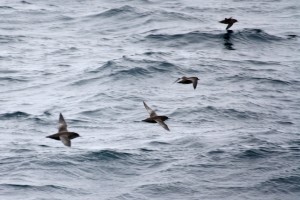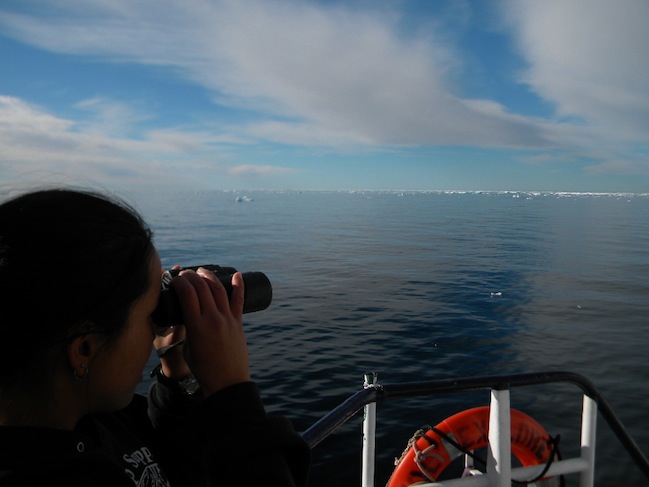Catherine looking for seabirds near the ice, photo by Alex Andrews
Why study seabirds at sea?
Catherine Pham is a student at Hawai’i Pacific University. She studies seabirds, but with a special twist… Catherine does all her research from a boat, trying to figure out what seabirds are up to and where they go when they are not breeding on land.
Over the next year, Catherine will share her research with us. I’m excited to learn what living on a boat, dealing with seasickness, and trying to identify seabirds at a distance is really all about. Here’s Catherine’s introduction to their study:
Seabirds are different from other birds because they spend almost all their lives at sea. For most seabirds, except some gulls, all their food comes from the sea, and seabirds only come back to land for a few months each year to breed.
Even though seabirds spend most of their time at-sea, most of what we know about seabirds comes from studying them on land! We don’t even know where some seabirds go when they’re not on land! This knowledge is crucial: without understanding where seabirds go at sea, why they go where they go, and when they go where they go, we will never completely understand them. Not knowing the answers to these questions also means we can’t make good decisions that affect seabird conservation.
 Short-Tailed Shearwaters in the Chukchi Sea, photo by Catherine Pham
Short-Tailed Shearwaters in the Chukchi Sea, photo by Catherine Pham
I work with Dr. David Hyrenbach (Hawaii Pacific University) and Dr. Kathy Kuletz (U.S. Fish & Wildlife Service, Alaska) on a large collaborative project that is looking at the arctic marine ecosystem in Alaska. Our part of this project focuses on the at-sea distribution of seabirds in the Bering and Chukchi seas.
The general background of this study is:
Different seabird species prefer different types of food. For example, Black-Legged Kittiwakes eat fish from the surface of the ocean, while Least Auklets use their wings to swim underwater and catch zooplankton. Food availability for these different seabird species can change from year to year due to changes in the environment like water temperature and salinity. It is therefore likely that seabird species that like the same type of food are found together in the same region.
What I want to find out is:
- Do seabird species that eat different prey have different distributions?
- Are certain species of seabirds generally found together in the same region?
- Do these distributions and groups of species change from year to year?
- Are the changes we see in seabird distribution related to changes in their prey?
Over the next school year, we will be learning more about this study including:
- The research team and funding that made this study possible
- How we study seabirds at sea?
- What do we already know about seabirds at sea?
- What makes a seabird community?
- What do seabirds eat, and how good are they at finding their prey?
Here are a few questions for you:
- How do you think we can study seabirds at sea?
- Where do you think seabirds from the Pribilof Islands, like murres and kittiwakes, go during the winter months when they’re not on the islands?
- Do you think they all go to the same area? Why or why not?

